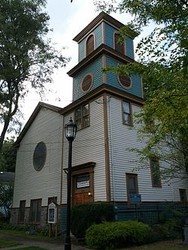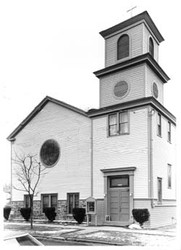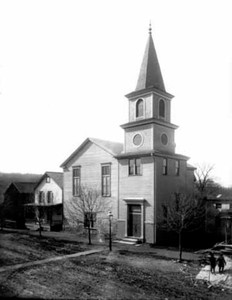St James A.M.E. Zion Church
Introduction
Text-to-speech Audio
Images
A modern look at the St James AME Zion Church.

An old photo of the church taken sometime possibly during the 1960s.

An old photo of the church taken some time possibly in the 1930s.

Backstory and Context
Text-to-speech Audio
Throughout the history of the United States, several religious structures have held a unique value among American Communities as places of worship for all. However, in addition to their functions as structures for divine refuge, these buildings have also played numerous roles that were helpful in more ways than one in reshaping America for the better. One of these churches is the St. James AME Zion Church situated in the town of Ithaca, New York. This can be said because, during the course of time that It has been present, the church itself has played a significant role in bringing together Americans especially African Americans into a community which they found acceptance among others when nowhere else would. Furthermore, it has played a huge role as a part of the historic “Underground Railroad” as a way station for runaway slaves en route to escape the confines of slavery in America in favor of the freedom in the North.
While the church building itself holds historic value, it is important to understand how the African Methodist Episcopal Church came into existence and why did it break into another branch. With approximately 2.5million members, 5,000 churches and 19 Episcopal districts worldwide, the African Methodist Episcopal church roots can be traced back to the earliest years of the United States. In November 1787 Richard Allen developed the belief that the message of Christ could change the hearts of Slave owners and in doing so would end racial enslavement, Black’s dependence on whites and their economic freedom. Following the development of these beliefs, Allen’s AME Church became a group that advanced Black economic determinism similar to the movement founded by Marcus Garvey in the 20th century.
The church prior to its’ creation was once based off the teachings of the John Street Methodist Church of New York City. Originally founded in October 12th, 1766 as the Wesley Chapel by the Wesleyan Society the oldest Methodist congregation in North America. Originally a blue Stucco barn built two years following its’ establishment, the church was moved to another location following the growth of the congregation. “This house must come down and something larger and better occupy its place.”[1] It was at this point that the church had reached the pinnacle of its’ power both economically and socially according to pastor Heman Bangs. “It is a responsible and important position which I am incompetent to fill.”[2] In the twenty-three year period following the creation of the second church the Congregation then opted for the creation of a new building. To this end, the trustees issued an appeal to help finance the construction of the new church. The appeal itself was well received and therefore gave the Board of Trustees the assurance that they had the right intentions for the American Methodists. The church that continues to occupy the financial district was built in April of 1841 in a building that helped complement the growing widening of Wall Street.
However, as time went on, divisions soon arose between members of the congregation, particularly white and African American members. Since the establishment of the Methodist faith in North America during its early colonial period, it has been favorably received by the African American denomination because of the scriptures’ identification with “the simple sort,” as well as its’ preaching against the practice of slavery. Although it appeared to have a more open message, the atmosphere present within the church maintained a deeply segregated feeling between its white and African American members. Specifically, they were forced to sit in segregated pews during services, limited their access to the Methodist inerrant clergy as well as the communion table and even denied ordination.
In response to this unfair treatment brought on by their white counterparts, the African denomination of Methodists broke away from the John Street congregation and entered into the newly established Zion church. Following the creation of the African Methodist Episcopal congregation, the AME Zion system broke off and started its own system around 1796. When a group of its’ own members sought to create an independent Black church. Organized by a former slave and employee of the John Street Church named Peter Williams, this new congregation established their first chapel in the shop of one of their members William Miller. The shop remained their place of worship for several years until 1800 the congregation received its own church. The motives behind the AME Zionists like its’ counterpart the AME has been the political activism of African Americans and spoke out against Anti-Slavery sentiments through the writings and preaching of their pastors. Although the African Methodist Episcopal Zion Church was a predominantly African sponsored congregation, around the years of the 1820s, the white sponsored congregations within the Methodist community began to centralize control of the AME’s properties since they were owned by white Methodist organizations.
In response to these actions, the African Methodist Church’s pastor, a white man by the name of William Stillwell resigned from his post in protest. One of these pastors was Thomas James who was an ardent supporter of antislavery motives and who played an active role in the church affairs. In addition to Mr. James, the church also featured other prominent antislavery figures such as Harriet Tubman and Frederick Douglas who was himself an ordained minister of the church itself. While the church was well known for its’ opposition against slavery, it would become more well known for its’ role as a way station for hundreds of slaves seeking salvation to the Northern territories of Canada. Since the Church was located in Ithaca which also served as an important role in the Underground Railroad because of its location near Canada, the church played a vital role in the means to help fugitive slaves in their escape towards Canada. In addition to helping runaway slaves reach Canada, the church further embraced those who chose to stay instead of going to Canada.
Since the church was located in Ithaca which also served an important role in the Underground Railroad, the church played a vital role in the means to help fugitive slaves in their escape towards Canada. In addition to helping runaway slaves reach Canada, the church further embraced those who chose to stay instead of going to Canada. Following the end of the Civil War in 1865, the need for the system of the Underground Railroad had run its course. However, with the conclusion of its chapter as a part of this legendary network to freedom, the Church nevertheless continued to serve African Americans well into the more tumultuous years of both the 19th and 20th Century. In the years following the end of the Civil War, the African Methodist Episcopal church of Ithaca, New York continued to function as both a place of worship as well as a cultural center for the community.
In the years following the Civil War, not only did the congregation grow, it competed with other independent African American Methodist and Baptist groups in attracting members. Between the years of 1821 and 1900, membership within the church increased at an exponential rate from 1,4000 to 350,000 which included its’ membership among women thanks to the ordination of Mary Julia Small and Julia Foote as the first female elders of the congregation. In addition to the growth of the church’s membership in the past seventy-nine years, the church like so many other African American denominations became influenced by the development of Black Nationalism, pan Africanism because of their emphasis on Black potential and economic autonomy. In the decade of the 1870s, the church took on a more serious role as it set out on Evangelical missions to regions such as England, Nova Scotia, the Caribbean, South America and Africa to uplift fellow African Citizens’ spirit as well as establishing churches in said locations to help spread the message of the church. “The AME Zion Church also made inroads into Africa who sailed for Liberia in 1876.”[3]
The missions launched by the church were not exclusively for male members to carry out, rather these missions included members of both sexes so as to generate a more unified congregation. The missionary work carried out by the members of the AME Zionist Church wherever they were was being recorded for the church’s growing number of publications including the Star of Zion first published in 1876 and the AME Zion Quality Review in 1890 which have been instrumental in the development of several prestigious schools such as Livingstone College and Booker T. Washington’s Tuskegee Institute.
The church had eventually amassed a membership number of half a million and at least thirty-six hundred churches with an additional twenty-five hundred churches with an additional twenty-five hundred ministers by 1900. Yet despite these overwhelming numbers, the AME Zion movement encountered several difficulties in trying to spread their message. To be specific, all denominations of the AME Zion movement whether they be in the American mainland or among the missionaries around the globe, the AME Zionist congregations faced troubles such as a lack of funds, church property, poor transportation and hostile residents who were not in favor of African American independence. While these problems were present throughout the AME Zion congregations worldwide, the movement eventually created thirty conferences across the United States by the end of the 19th century.
Throughout the course of the course of the 20th century, it was during the initial years that the St James congregation would continue its role in the advancement of African Americans during this tumultuous period. Specifically, in 1906, the church served as a meeting place for the nations’ oldest African American fraternity Alpha Phi Alpha of Cornell University when seven African American became frustrated by the discrimination of the all-white fraternities on campus. However, while this incident became a major boost for the AME Zionist congregation, it would be the role which it would play during the Civil Rights period of the 1960s that the church would play another dramatic role in helping African Americans gain a strong foothold in the field of equality.
Throughout the course of the Civil Rights movement, the AME Zionist branch in Tuskegee Alabama, specifically the Butler Chapel served as a focal point for multiple projects which helped African Americans fight for the right to vote. One such incident in which the church fought against inequality occurred in 1957 when the African Americans of Tuskegee protested being unconstitutionally placed outside the city limits during the course of the election so as to avoid the actual numbers of African American voters. To counter this betrayal, on June 25th, 1957, 3,000 African American residents attended the Butler chapel and were urged by Tuskegee Institute Professor Charles Gomillion to boycott local white merchants. “We are going to buy goods and services from those who help us from those who recognize us as first-class citizens.”[4] Around the 1980s the Ithaca church had achieved a status on the National Register of Historic Places and continues to this day to carry on and function as an operational church to this very day with members that included influential leaders such as Thurgood Marshall, Olympic athlete Jessie Owens and even off the African Methodist Episcopal Zionist movement has continued to maintain a presence in countries that included the United States, England, Canada, the Caribbean, Africa, India and South America under the supervision of 12 elected Bishops and is continually at the forefront of the battle for full citizenship and freedom wherever it maintains a presence.
Sources
[3] Pinn, Anne H. and Anthony B. Pinn. Fortress Introduction to Black Church History. Minneapolis, MN: Augsburg Books, 2002.
[4] Djupe, Paul and Laura Olsen. Encyclopedia of American Religion and Politics. New York, NY: Facts on File Inc., 2003.
Additional Sources:
Appiah, Anthony and Henry Louis Gates, Africana: The Encyclopedia of the African and African American Experience, 2nd ed. 2004.
“Open Doors: St James AME Zion has long legacy of Welcoming.” Ithaca.com. Last modified February 27th, 2012. Accessed April 25th, 2015.
http://www.ithaca.com/news/open-doors-st-james-ame-zion-has-long-legacy-of/article_3390843c-5e62-11e1-8ae4-0019bb2963f4.html.
